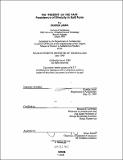| dc.contributor.advisor | Ronald B. Lewcock. | en_US |
| dc.contributor.author | Jamal, Khadija | en_US |
| dc.contributor.other | Massachusetts Institute of Technology. Dept. of Architecture. | en_US |
| dc.date.accessioned | 2012-10-26T19:00:49Z | |
| dc.date.available | 2012-10-26T19:00:49Z | |
| dc.date.copyright | 1989 | en_US |
| dc.date.issued | 1989 | en_US |
| dc.identifier.uri | http://hdl.handle.net/1721.1/74482 | |
| dc.description | Thesis (M.S.)--Massachusetts Institute of Technology, Dept. of Architecture, 1989. | en_US |
| dc.description | Supervised by Ronald B. Lewcock. | en_US |
| dc.description | Includes bibliographical references (leaves 118-121). | en_US |
| dc.description.abstract | The subject of this thesis was generated by the prevailing social situation in the city of Karachi, where many communities and ethnic groups co-exist in ethnically defined areas. At the beginning of the research it was clear that a study of the importance of kinship and communal living in the perpetuation of traditions and in the development of cultures would have to be included. The endurance of ethnicity in realized built form became the crux of the entire study. In tracing back the infiltration of the muhajirs into Pakistan's prime city of Karachi and its impact on domestic spatial planning, this inquiry attempts to explore the influencing factors in cross-ethnic differences and to a certain extent trans-class similarities. A number of aspects make this entire exercise curiously stimulating and intellectually invigorating: - Inadequate existing literature on the relationship between culture and built form in this context. - The presence of a great variety of ethnic influences in Karachi that add many dimensions to the richness of diversity and similarities. -Reflection of these in the every-day architecture which is constantly being created by the people and the professionals. The thesis, while establishing its theoretical framework on cultural interpretations, uses structuralists' perspective to view the case studies in order to ascertain the many influencing aspects of ethnicity and cultural continuity in the context of Karachi. The case studies are based on first hand data compiled by the author through site visits, which involved surveys of houses built by the people, observations of uses of various spaces within the houses, and interviews with residents. These are supported by oral information obtained in discussion with people in the field, and by existing documented information wherever available. On analyzing these data many reflections surfaced which centered around the cultural endurance and persistence of ethnicity in built form. | en_US |
| dc.description.statementofresponsibility | by Khadija Jamal. | en_US |
| dc.format.extent | 122 leaves | en_US |
| dc.language.iso | eng | en_US |
| dc.publisher | Massachusetts Institute of Technology | en_US |
| dc.rights | M.I.T. theses are protected by
copyright. They may be viewed from this source for any purpose, but
reproduction or distribution in any format is prohibited without written
permission. See provided URL for inquiries about permission. | en_US |
| dc.rights.uri | http://dspace.mit.edu/handle/1721.1/7582 | en_US |
| dc.subject | Architecture. | en_US |
| dc.title | The "present" of the past : persistence of ethnicity in built form | en_US |
| dc.type | Thesis | en_US |
| dc.description.degree | M.S. | en_US |
| dc.contributor.department | Massachusetts Institute of Technology. Department of Architecture | |
| dc.identifier.oclc | 20654588 | en_US |
